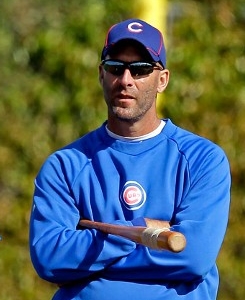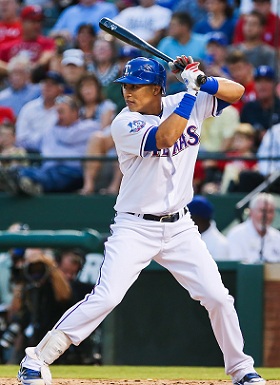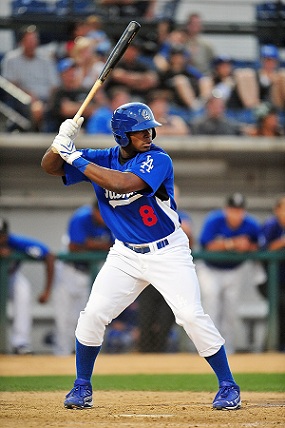Jurickson Profar is almost universally considered the game’s top prospect but he doesn’t yet have a spot in the Rangers’ lineup. (Landov)
Myers, Bundy, Profar lead top rookies who could impact AL
Though they didn’t arrive until the end of April, Mike Trout and Bryce Harper took the majors by storm last year, living up to the considerable hype they received as prospects to deliver history-making seasons for their ages (20 and 19, respectively) and win Rookie of the Year honors. In addition, Harper helped the Nationals to their first playoff appearance, while Trout nearly took home American League MVP honors despite Miguel Cabrera’s Triple Crown.
The odds are against seeing such stellar performances from top rookies in 2013 — those were once-in-a-generation showings, if not once-in-a-lifetime ones — but that doesn’t mean we’ll have a shortage of outstanding rookies, and right now is the season to dream on them. On Wednesday, Baseball America released its Top 100 Prospects list, the most hotly anticipated of the major rankings of minor leaguers but by no means the only one. MLB.com’s Jonathan Mayo and ESPN Insider’s Keith Law have also published their lists, while those of SB Nation’s John Sickels and Baseball Prospectus’ Jason Parks are still a week away; the latter is timed to coincide with the publication of BP’s annual book, of which I’m a part for the eighth consecutive year.
Since I’m not a scout, and have seen very few of the players on the lists myself, those are the people I turn to when I want information about young players on the rise, and if you’ve been reading this space, you know that I tend to distill their reports and opinions into information I can use here. What follows is a look at a handful of prospects who could have real impacts for AL teams in 2013 (a similar selection of National Leaguers will follow). They may not be the team’s best prospect overall, and may not break camp with the big club, but they’re the best bets to make significant contributions some time this year. They’re ranked according to my own understanding of what they’ll contribute in 2013.
JAFFE: Top rookies who could have an impact on the National League in 2013
RF Wil Myers, Rays.
Myers, a player I’ve written about frequently, is BA’s reigning Minor League Player, coming off a 37-homer, .314/.387/.600 season split between Double-A and Triple-A, and the focal point of the winter’s most controversial deal, that between the Royals and the Rays. Ranked fourth on BA’s list, the 21-year-old righty is major league ready, with a middle-of-the-lineup profile as a hitter, but service time issues will almost certainly prevent him from breaking camp with the Rays. Whether his arrival time is decided by the idea of milking an extra year before free agency (indicating a late April recall) or arbitration (likely sometime in June) remains to be seen.
RHP Dylan Bundy, Orioles.
The fourth pick of the 2011 draft out of an Oklahoma high school, Bundy rocketed up the ladder in his first professional season, putting up a 2.08 ERA with 10.3 strikeouts per nine in 108 2/3 innings at three stops before making a brief cameo at the major league level — all of 1 2/3 innings in two late September relief appearance. Not too shabby for a 19-year-old who wound up second on BA’s list.
Bundy complements a near-elite level 94-98 mph fastball with above-average curve and changeup, though his command still needs a bit of work. If service time and workload weren’t concerns, he’d have a shot at starting the year in Baltimore’s rotation, but he’s probably going to be limited to 140-160 innings overall, with a call-up in the second half. The Orioles have no shortage of other options, but odds are that they won’t get the same level of outstanding work across 90 starts from Jason Hammel, Miguel Gonzalez and Chris Tillman that they did across 50 last year. With former top prospects Brian Matusz, Jake Arrieta and Zach Britton around as both options and cautionary tale, there’s enough depth to buy time until Bundy gets more seasoning in the upper minors, given that he threw just 16 2/3 innings at Double-A.
RHP Trevor Bauer, Indians.
As with Myers, if you’ve been reading this space, you’re familiar with Bauer, who was chosen one spot ahead of Bundy out of UCLA in the 2011 draft. The now-22-year-old gained attention for his unorthodox throwing program and extreme long-toss regimen, but struggled in four big league starts with the Diamondbacks. Beyond his control problems (13 walks and two wild pitches in 16 2/3 innings), he battled with catcher Miguel Montero and other teammates, so general manager Kevin Towers made a statement by gifting him to the Indians in an unbalanced three-way trade.
Bauer’s exceptionally deep repertoire stars a 93-95 mph fastball that can touch 97, an outstanding curveball, an average-to-above-average slider with a two-plane break, a deceptive, late-breaking changeup and even a splitter and a cutter. Given that he has whiffed 11.5 per nine in his three minor league stops, he’s a welcome addition to the strikeout-poor Indians rotation, but in order to succeed, he’ll have to adjust to the major league level with less hard-headedness than he showed in Arizona.
RHP Bruce Rondon, Tigers.
A 6-foot-2, 265 pound flamethrower whose fastball has been clocked as high as 102 mph, Rondon isn’t just the closer of the future for the Tigers, he’s the closer of the present despite throwing just eight innings at Triple-A and none in the majors thus far. Detroit let Jose Valverde depart as a free agent and avoided overpaying for an established ninth-inning vet because it wants to give the 22-year-old a shot at the job. Rondon’s maximum-effort delivery can lead to struggles with his control and command, particularly when it comes to his slider, his second pitch; that said, he cut his walk rate from an unsightly 7.6 per nine in 2011 to 4.4 per nine last year while striking out 11.2 per nine in 53 innings split between three levels. The length of his leash remains to be seen; Phil Coke, Octavio Dotel and Joaquin Benoit could be used to close games while Rondon acclimates to the majors, but if he’s too wild or otherwise struggles, he could find himself back in Triple-A.
C Mike Zunino, Mariners.
Seattle is known more for its trio of top pitching prospects (Taijuan Walker, Danny Hultzen and James Paxton), but Zunino, who turns 22 on March 25, could beat them to the show and make his mark sooner. The third pick of last year’s draft out of the University of Florida, he hit a sizzling .360/.447/.689 with 13 homers in 190 PA at Low-A and Double A, and threw out 43 percent of would-be base thieves. He’s both a polished hitter with quick hands and average or better power as well as a decent receiver. The Mariners are apparently going to give the defensively questionable Jesus Montero a long look behind the plate early in the year, and they brought in Kelly Shoppach as a backup/insurance policy, but the consensus is that after gaining more upper-level minor league experience (he played just 15 games at Double-A), Zunino could find his way to Seattle sometime this summer.
CF Aaron Hicks, Twins.
The combination of trading both Denard Span and Ben Revere this past winter was something of a headscratcher given that it left the Twins with Darren Mastroianni as the likely opening day centerfielder. It all makes more sense, though, given that the switch-hitting Hicks enjoyed a breakout year at Double-A (.286/.384/.460 with 13 homers and 32 steals). A 2008 first-round pick out of a California high school, Hicks had progressed slowly up the ladder due to a surprising dearth of in-game power and an approach that some considered too passive (as in, “What was wrong with that pitch?). Now 23 years old, he has improved his pitch recognition skills as well as his power. He has the speed for centerfield, not to mention an outstanding arm. If he can avoid his typically slow starts, he could debut for Minnesota sometime this summer.
IF Jurickson Profar, Rangers.
Ranked number one on all four aforementioned prospect lists, Profar turned 20 on Wednesday. As a 19-year-old, he hit .281/.368/.452 with 14 homers and 16 steals at Double-A Frisco, then made a nine-game cameo with the Rangers. As Law summarizes, Profar offers “an incredible combination of tools, skills, and baseball instincts rarely found in players who play in the middle of the field. His feel for the game is unusual for a player of any age…” That assortment include an exceptional arm and an outstanding approach at the plate, not to mention considerable power. The problem — and the reason he’s not ranked higher here — is that the Rangers’ shortstop spot is occupied by the young and talented Elvis Andrus, and a shift by second baseman Ian Kinsler to first base has been considered but dismissed for the moment, leaving Profar without a clear major league role. The team may consider him in a utility spot, and a couple of talent evaluators familiar with the system think that they might reconsider the Kinsler move this spring, so he’s worth a spot here.
LHP Martin Perez, Rangers.
Perez ranked 81st on BA’s list, the fifth year in a row he made the cut, though his stock has fallen from when he ranked 17th going into 2010. He was introduced in this space last June, just before his major league debut, but the 21-year-old lefty scuffled in six starts and six relief appearances totaling 38 innings, with a 5.45 ERA due to high BABIP and walk rates. His numbers at Triple-A Round Rock (4.25 ERA, 4.0 walks and 4.9 strikeouts per nine) weren’t all that good either, as he sacrificed strikeouts for efficiency. Even so, he offers above-average raw stuff, starting with a great late-fading changeup and a 92-95 mph fastball that can go higher; his curve lacks consistency but is at least average with the potential to be better. He’s a fifth starter candidate who will nonetheless need a good spring to win the job.
RHP Chris Archer, Rays.
Like Myers, this 24-year-old righty was also acquired via a blockbuster, in this case the Matt Garza deal with the Cubs —
the second time he was traded since being drafted in the fifth round by the Indians in 2006. Archer threw 29 1/3 innings for the Rays last year, with a 36/13 strikeout-to-walk ratio, after putting up a 3.66 ERA with 9.8 strikeouts per nine for Triple-A Durham. His signature pitch is his two-plane slider, which he backs with a 93-97 mph fastball and a changeup that still needs some refinement. Command is an issue; he has walked 4.3 per nine in 141 innings at Triple-A, and was at 4.0 during his brief major league stint. He doesn’t have a guaranteed rotation spot, but could challenge Alex Cobb or trade candidate Jeff Niemann, or simply continue to work out of the bullpen while he awaits an opening.






